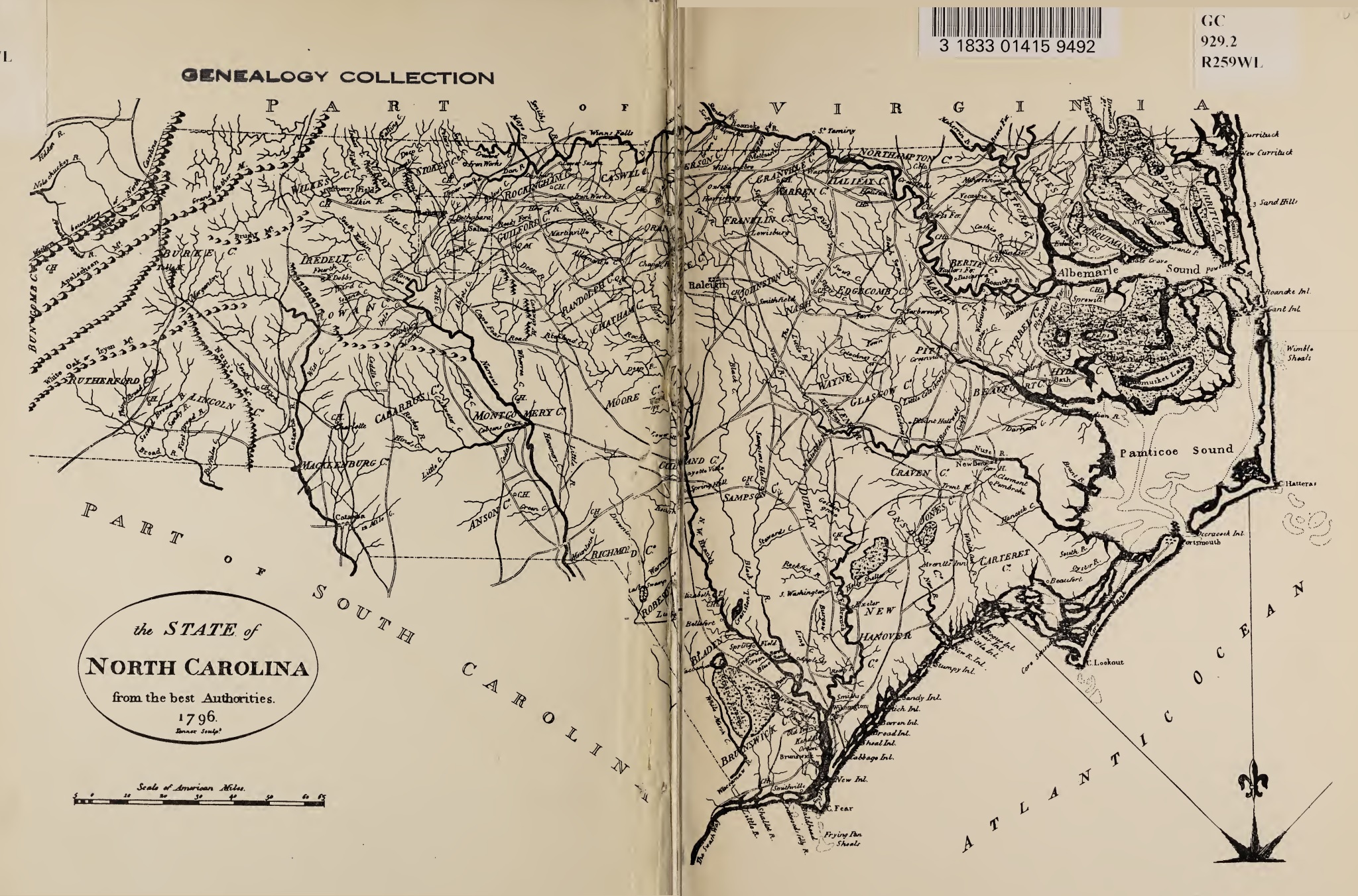1756
August 1, 1756.
George Washington, Speech to Tuscarora Indians (including Meherrin Indians)

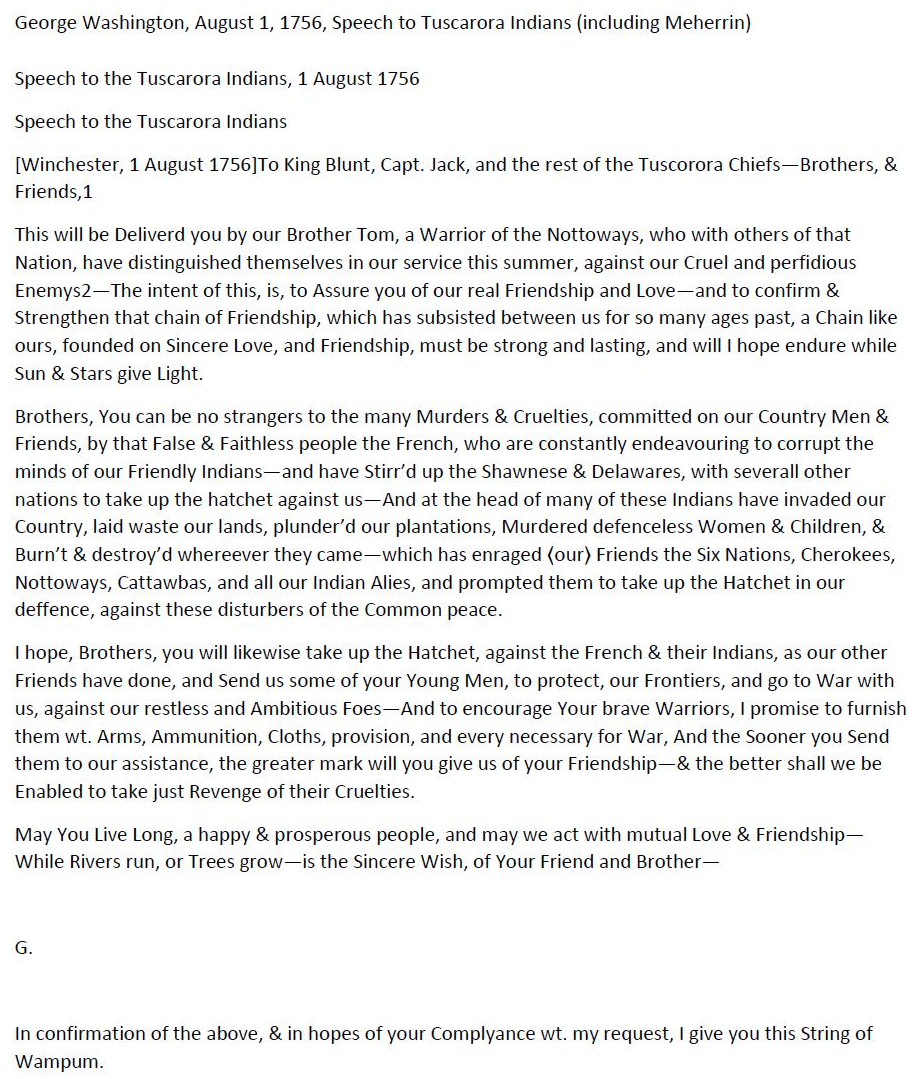
1756
Captain Tom (Nottoway) was asked by George Washington to go to the Tuscarora (which would have also included the Meherrin) and ask them to join the war.
I have supplied the Nottoway Indians with some necessaries, and have allowed them to take their arms with them; but they have received no pay, and say, they were promised a Bitt per day.
Captain Tom has promised to go to the Tusks with Speech and Wampum, which I have given them-He says they have an hundred fighting men to spare-They would be a great assistance to us, if they could be engaged to come.
1756
From George Washington to Robert Dinwiddie, 8 September 1756.
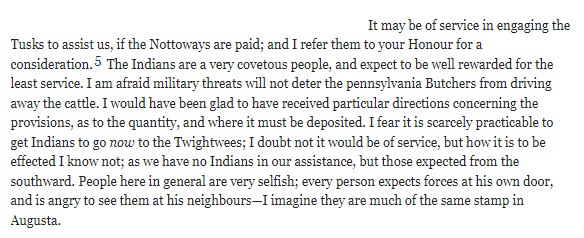
1757

1757
March 31st, 1757.
William Fairfax to George Washington.

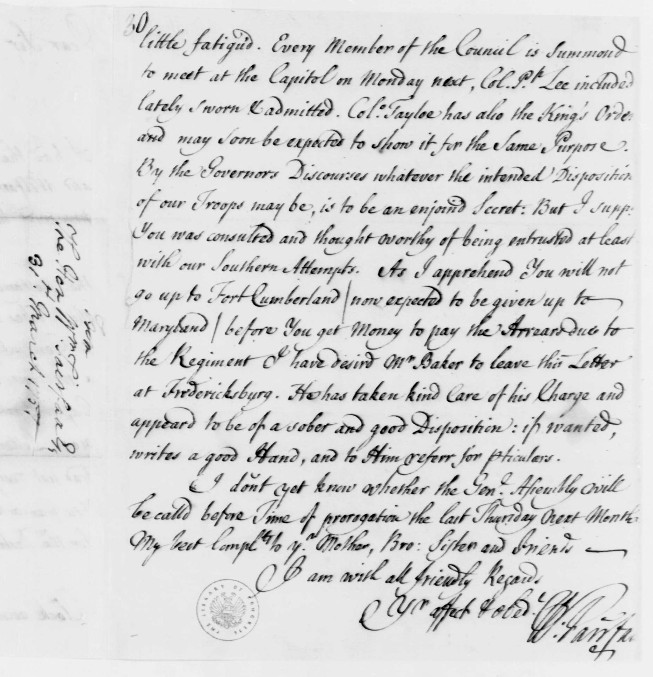
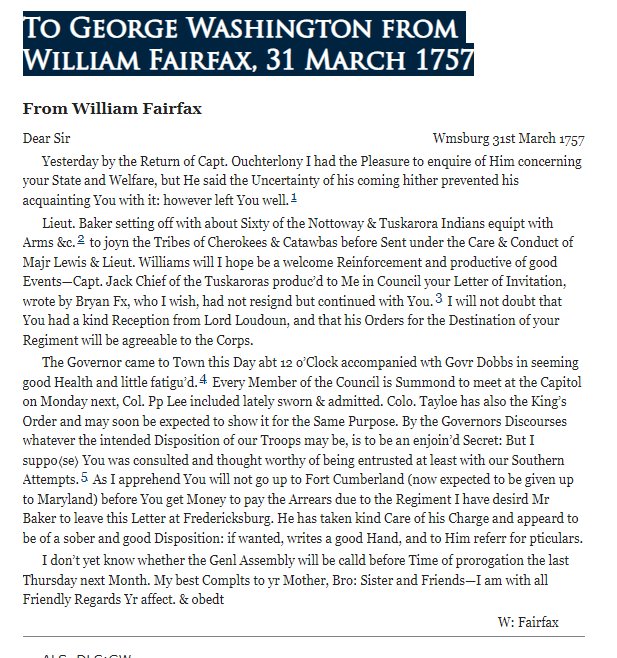
1757
April 1st, 1757.
The recruitment efforts the Cherokees had previously made among the Nottoways was about to bear fruit via Lietenant James Baker. On April 1, a newspaper in Williamsburg described the southern Amerindians accompanying Baker northward, “39 Tuscaroras, 13 Nottoways, seven Meherrins, and two Sappony’s. ” By April, large numbers of Cherokees and Catawbas were making their way over hundreds of miles to Virginia and points north.
1757
Meherrin – French & Indian War.
In 1757, Meherrin soldiers responded to a call from Colonel Washington to fight in the French and Indian Wars. They were going to fight as Indians.
The President… gave an Audience to King Blunt and thirty three Tuscaroroes, seven Meherrins, two Saponies and thirteen Nottoways [they] said what the Colonel had writ was very agreeable to them, and they had heartily accepted the Invitation, all they wanted was to be assisted with Arms, Ammunition, Cloathing, and Paint – they had buried deep under Ground their Guns, Tommahawks, and Hatchets; but exasperated and inflamed by the shocking cruelties exercised on their Brethren by the French and their base Indians, they had now concured in raising up their Arms determined not to lay them down till they had vanquished their barbarous Enemies, or proved their Fidelity by dying in the Attempt…
(Mcllwaine, Vol. VI:34, 38-39. April 4, 1757).
(The Secret History of the Meherrin page 110)
1757
Meherrin – French & Indian War.
“The President acquainted the Board that, on the 29th of last Month, he with Mr. Auditor and Mr. Commissary gave an Audience to King Blunt and thirty three Tuscaroroes, seven Meherrins, two Saponies and thirteen Nottoways, who came in Company the Day before to Williamsburg; that after saluting them all and desiring them to sit, he addressed himself to them in these Words. “I have given you this early Meeting, in order to hear what you have to propose, and to know your Wants that they may be speedily supplied.” That Captain Jack the Chief of the Tusks next to the King who was old and feeble, produced and delivered to him a Letter from Colonel Washington inviting and encouraging them to come and join us against our Enemies and said what the Colonel had writ was very agreeable to them, and they had heartily accepted the Invitation, all they wanted was to be assisted with Arms, Ammunition, Cloathing, and Paint – they had buried deep under Ground their Guns, Tommahawks, and Hatchets; but exasperated and inflamed by the shocking cruelties exercised on their Brethren by the French and their base Indians, they had now concured in raising up their Arms ditermined not to lay them down till they had vanquished their barbarous Enemies, or proved their Fidelity by dying in the Attempt- To which Speech he returned the following Answer.
Brethren We are glad to see you and to know that you are come with willing and chearful Hearts to join and assist your Brethren the English in defending our and your Country against the unjust and wicked Attacks of the French and their deluded Indians. We shall furnish you with Arms, Ammunition, and Cloathing, and what more you are now in Want of, going to War. And as w e hope your Bravery will make you successful, so you may depend on King George’s
further Favor, and of our giving you Rewards on you Return from War as each shall deserve…. We heartily shake Hands with you and bid you Farewell.”
Virginia Executive Journals VI: 34, 38-39. April 4, 1757.
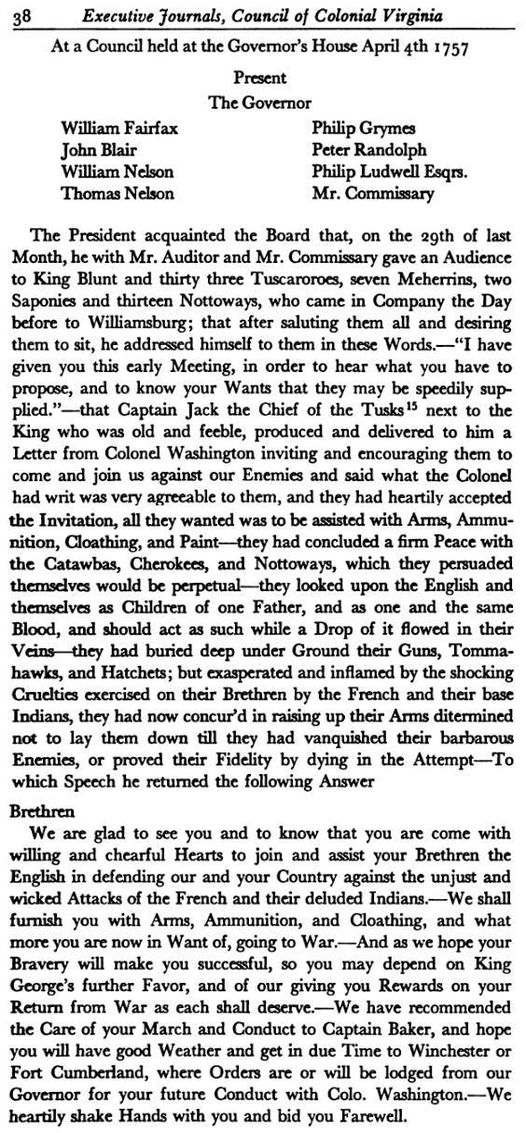
1757
Meherrin – French & Indian War.
House Resolution
“[resolved] that the sum of 40 pounds money be paid to Mr. Williams and Mr. Whitemell out of the taxes to be applied by them in purchasing provisions for the wives and children of the Tuscarora and Meherrin Indians who are gone (to the assistance of Virginia).”
North Carolina Colonial Records (Saunders) V: 839. May 26, 1757.
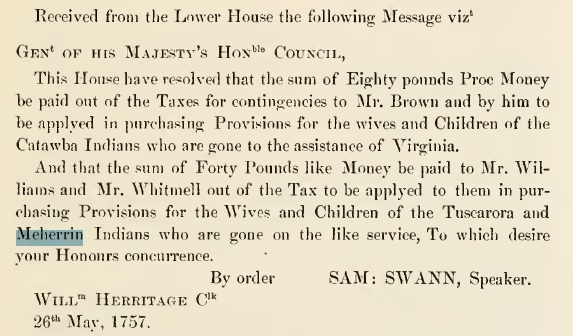
1757
Thomas Whitmell represented Bertie County in the Assembly during the period 1754–60 and while so serving was delegated to deal with Indian affairs. Late in 1757 some Indians appeared in New Bern to visit Governor Arthur Dobbs, producing a scalp to demonstrate that they had been in action against the “Swanees.” Whitmell was allowed £10 from the public treasury to be laid out in presents for the Indian allies.
1757
May.
At the beginning of 1755, when the Tuscarora in the county had one hundred fighting men, the colony called on them for help in the French & Indian war then in progress. In May 1757 Whitmell was awarded £40 for the relief of the wives and children of the warriors from the Tuscarora and Meherrin tribes who had gone to the assistance of Virginia.
1757
May 25, 1757
The House met according to Adjournment.
Received from the Council the Message of this House of the 25th of May 1757 relatives to the Allowances resolved by this House for the Catawba and Tuscarora Indians and Meherrin Indians. Endorsed 26th of May In the Upper House Concurred with.
The Colonial Records of North Carolina.

1757
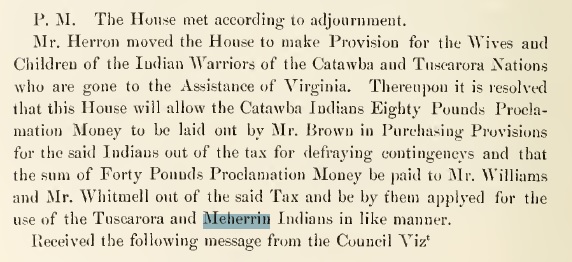
1757

1757
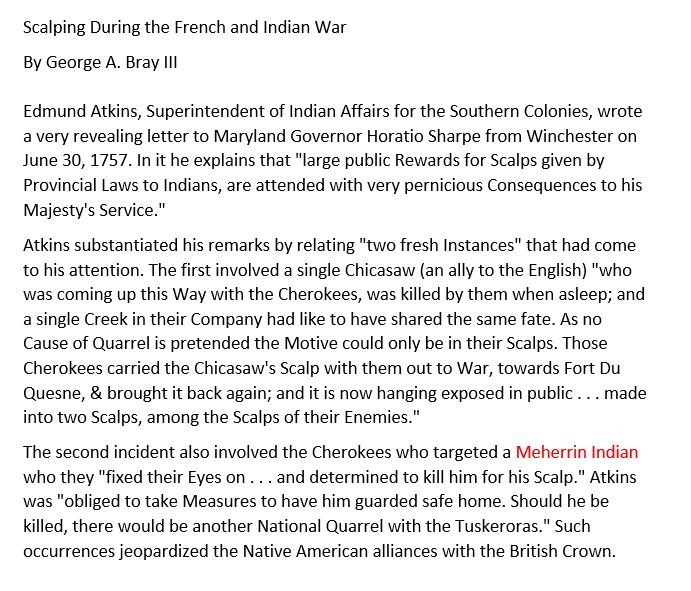
1757
Meherrin – French & Indian War.
“King Blunt and the thirty three Tuscaroras, seven Meherrins, two Saponies and thirteen Notoways” enlisted at Williamsburg with George Washington’s regiment to aid in the French and Indian War. The Tuscarora and Meherrin contingent said that they had “buried their weapons” and would only use them to fight a true enemy. As the Colonists were their friends, they would fight for them until the enemy was defeated at which time they would rebury their weapons.
1757
In 1754 there were 100 Tuscarora Warriors listed in Bertie County of which some were Meherrin. Also lists 7-8 Meherrin Warriors in Granville County.
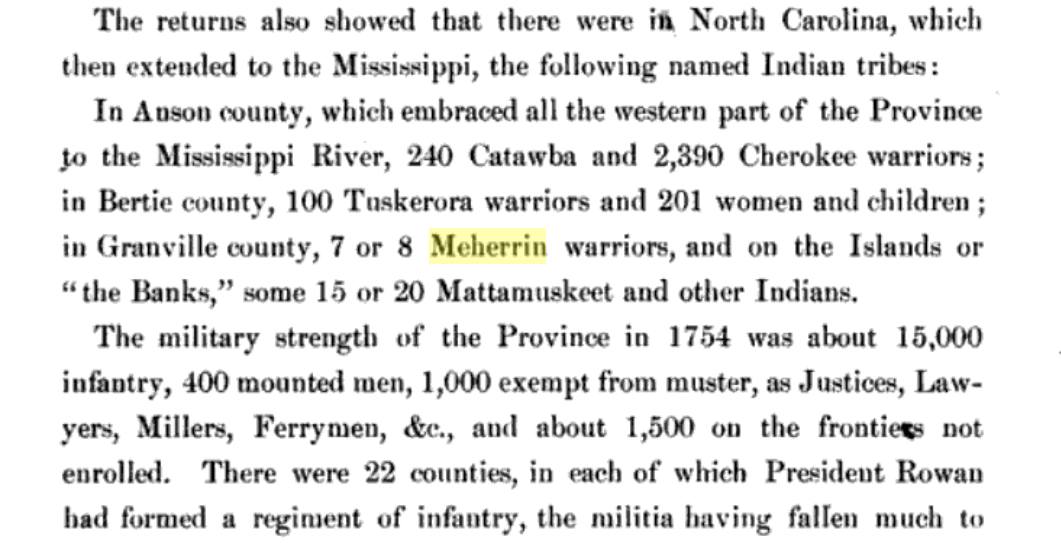
1757
Meherrin – French & Indian War.
Edmund Atkins, who was the Superintendant of Indian Affairs, cited an example of brotherhood between the Meherrin and Tuscarora. He said there was a party of Cherokees who wanted to take the scalp of a Meherrin, and that if this were to happen it would cause ”another National Quarrel with the Tuskeroras” and that this would threaten alliances with the Crown.
Pennsylvania Archives- 199-200.
1758
To George Washington from Francis Fauquier, 25 June 1758
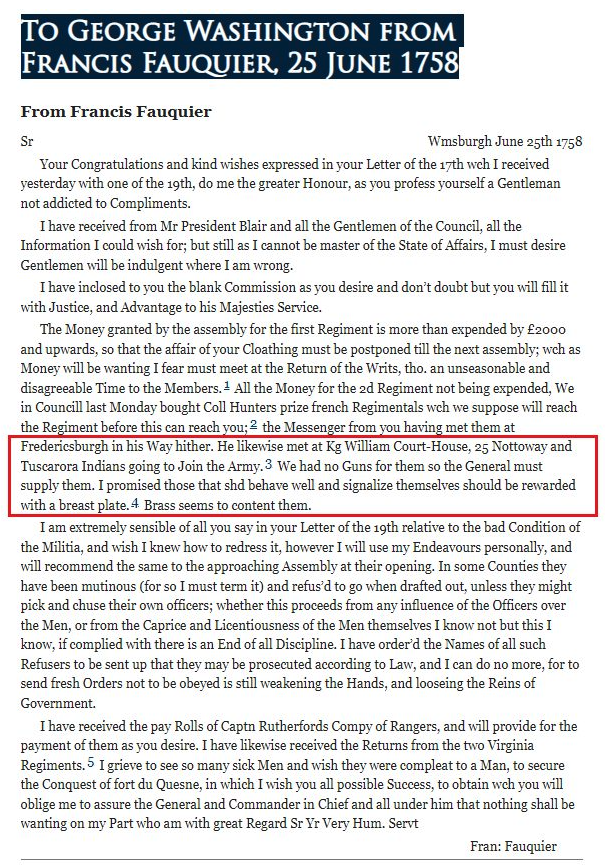
This gorget comfortably dates ca. Seven Year War aka the French and Indian War to the period spanning the American Revolutionary War. The ones given to the Nottoway, Tuscarora, and Meherrin who would have “behaved themselves” would have been made of brass.
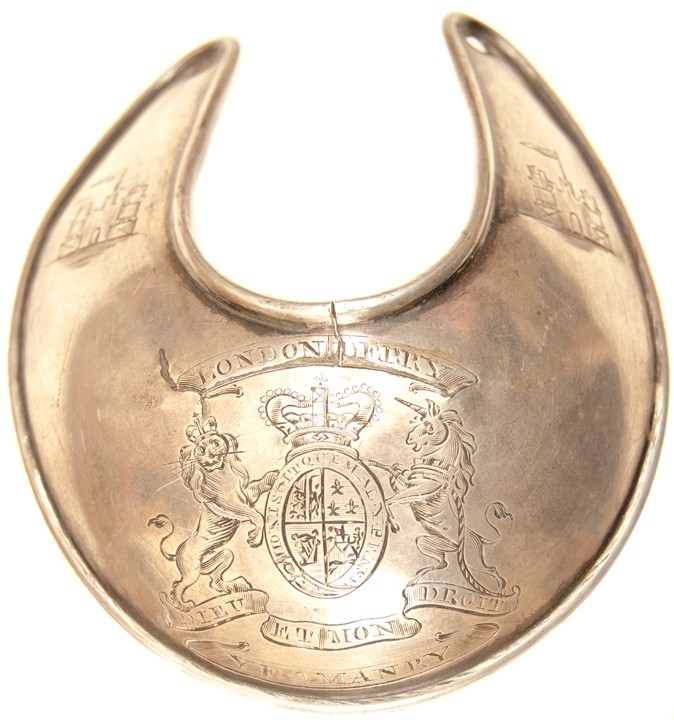
1758
July 20, 1758.
To George Washington from Christopher Gist.
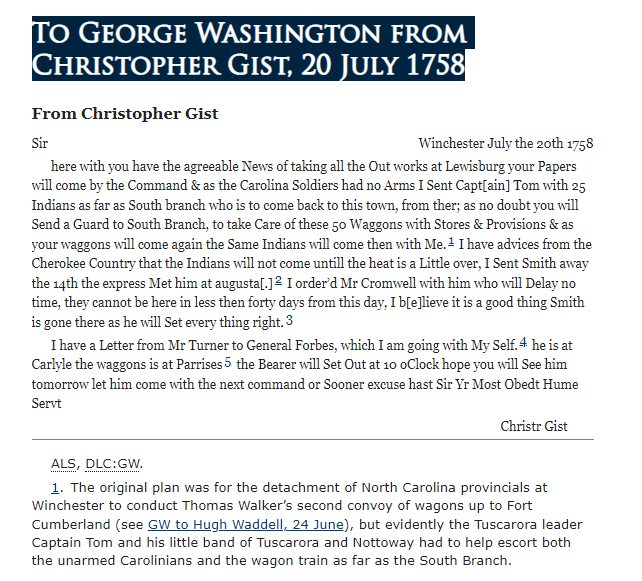
1758
August 24, 1758.
From George Washington to Henry Bouquet.
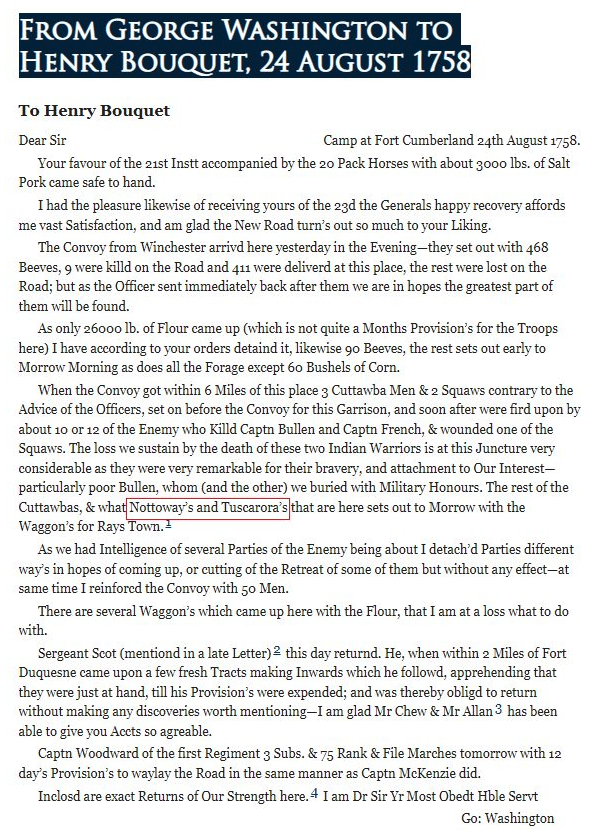

1758
In 1758, the North Carolina council passed a
resolution to help enforce the rights of the Meherrin:
Upon complaint of the Meherrin Indians being disturbed in their possession by several persons, contrary to act of 1729, Ordered that the Attorney General do prosecute all persons who disturb the said Meherrin Indians in their possessions

1758
Northampton-Northampton County John Dawson Coll: 7 Companys officers included 739 Captain William Short recommended for Major as eldest Captain in Room of Major James Manny deceased The return suggested to be Short by200 No arms & c in store no Indians but the Meherrins about 7 to 8 fighting men,
1758

1758
On May 4, 1758, the General Assembly resolved that Governor Dobbs “endeavor to prevail with a number of the Tuscarora Indians to march with the Troops of this Province” and join British forces in Virginia. The lawmakers sought to induce the Indians into military service by paying each man a bounty of forty shillings. The Indian warriors were also to be rewarded upon their return according to their “merit” while in service. Furthermore, the lawmakers authorized £40 to be withdrawn from the State treasury and provided to William Williams and Thomas Whitmell for purchasing provisions for the wives and children of those Tuscarora men who went to Virginia. The number of Tuscarora warriors who trekked to participate in action against the French is not evident in extant records, but some certainly participated in a large-scale campaign led by Gen. John Forbes to drive the French out of the upper Ohio River Valley. British forces, which included Indians, attacked Fort Duquesne (near present-day Pittsburgh, Pennsylvania) on September 14, 1758, but were repulsed. In May 1759 the North Carolina General Assembly resolved that £105 be given to the Tuscarora Indians as a bounty and reward for their services on the expedition against Fort Duquesne.
“The government most likely looked on the Meherrin and Tuscarora at this time as one of the same and omitted mention of the Meherrin for this reason”.
1758
There seem to have been twenty-eight Nottoway and Tuscarora Indians in Winchester by early July. At some point they went to Fort Cumberland and then in late August to Raystown. According to Bouquet they did “trés bien” in Maj. James Grant’s disastrous engagement with the French and Indians near Fort Duquesne on 14 Sept. 1758 (Bouquet to Forbes, 17 Sept. 1758, in Stevens, Bouquet Papers,

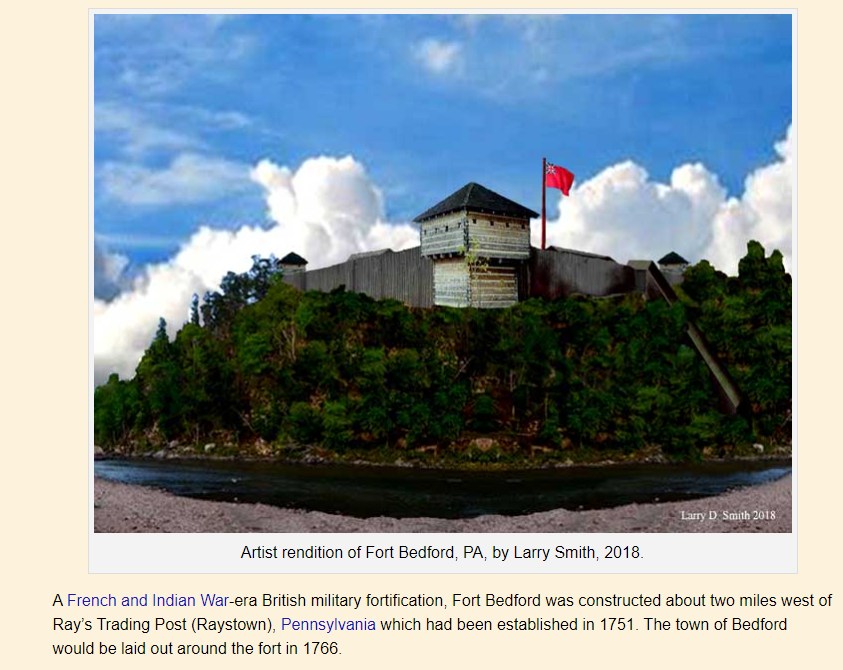
1761
Response to Queries from Board of Trade.
“Quere 13 What is the number of the Indians inhabiting those parts of America lyeing within or bounding upon your province? What Contracts or Treaties of Peace have been made with them and are now in force? What Trade is carried on with them and under what Regulations and how have these Regulations been established
Answer The only Tribes or remains of Tribes of Indians residing in this Province are the Tuskerora Sapona Meherin and Maramuskito Indians. The Tuskerora have about 100 fighting men the Saponas and Meherrin Indians about 20 each and the Maramuskitos about 7 or 8. the first 3 are situated in the Middle of the Colony upon and near Roanoak
and have by Law 10,000 acres of Land allotted to them in Lord Granvilles District they live chiefly by hunting and are in perfect friendship with the Inhabitants.”
North Carolina Colonial Records (Saunders) VI: 616. 1761.
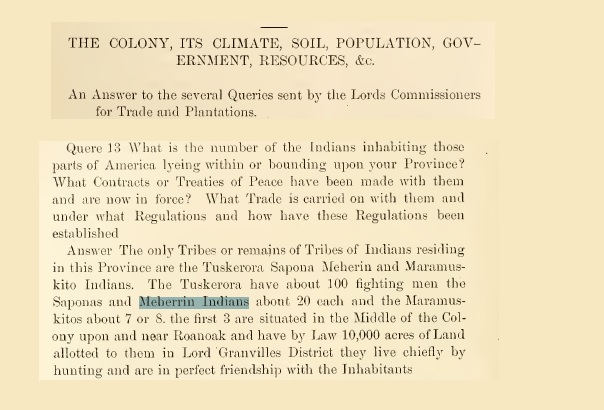
1761
In 1761 20 Meherrin fighting men and their families are documented as living with the Tuscarora, Saponi, and Maramuskito Indians at Indian Woods Reservation.
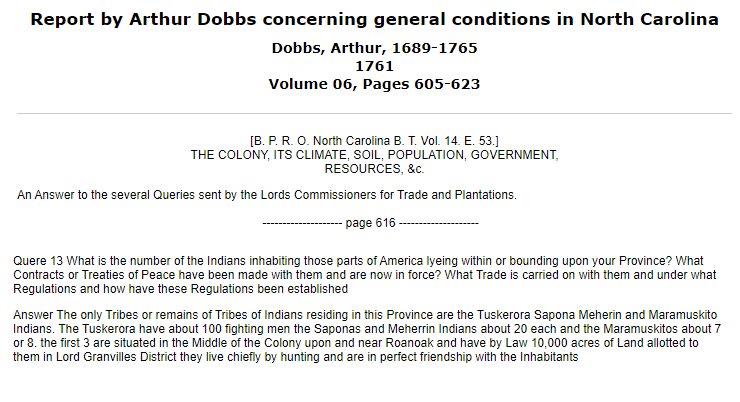
1761
A 1761 report to the Board of Trade says the Meherrin and Tuscarora “live chiefly by hunting” (Document B-83). This would be a consistent “grammatical” pattern; it did not require a redefinition of male roles or the basis for esteem in the community. That agriculture was not the sole support of the reservation is suggested by the fact that the Meherrin requested and received provisions for their women and children while the men were away to war
(Document B-81).
(The Secret History of the Meherrin page 111)
1761
Some of the Meherrin settled with the Tuscarora Nation. Later, as the Tuscarora reservation was leased, many within the community disbanded and relocated.
1763
Dobbs to Board of Trade.
“… we have no complaints or leagues with the Catawba Indians who are now reduced to less than fifty fighting men, the Tuskaroras and Meherrens being also reduced…”
North Carolina Colonial Records (Saunders) VI: 989. June 17, 1763.
1763
A group of Meherrin were noted as still residing in Virginia: “they live in peace in the midst of us, lead in great measure the lives of wild Indians”
(The official papers of Lt. Governor Francis Fauquier of Virginia).
1763
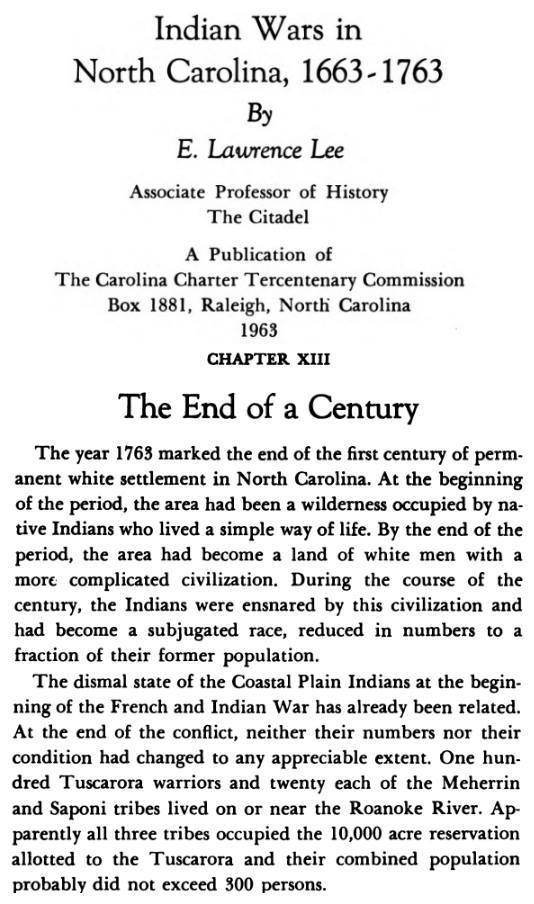
1766
A group of Meherrins (Akawantcaka) moved up to join Haudenosaunee Communities in New York, as documented by Ray Fadden in his Educational Poster titled “Five Nations and Others”
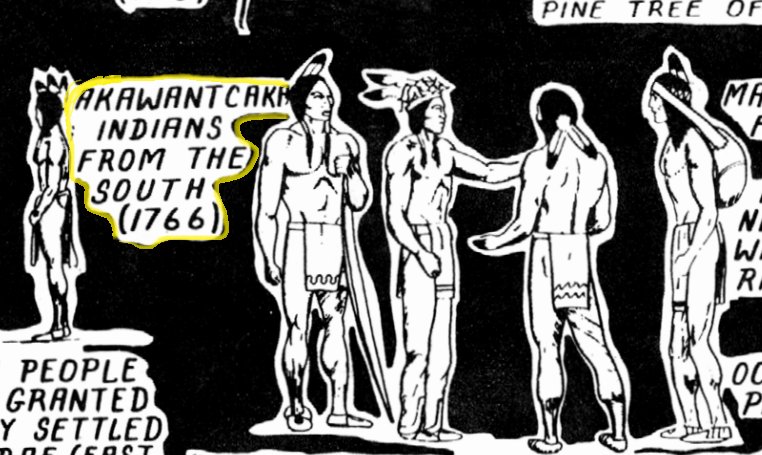
1770
The Collet map of 1770 provides the only clue regarding the date the Meherrin left their
reservation lands [Figure 11]. This map fails to show any Meherrin settlement in the neck, but it clearly plots the “Meherrin Indians Town” southwest of the river mouth, along Meherrin Creek (later called Potecasi Creek).
Published according to Act of Parliament, May the 1st, 1770, by S. Hooper, No. 25 Ludgate Hill, London.”

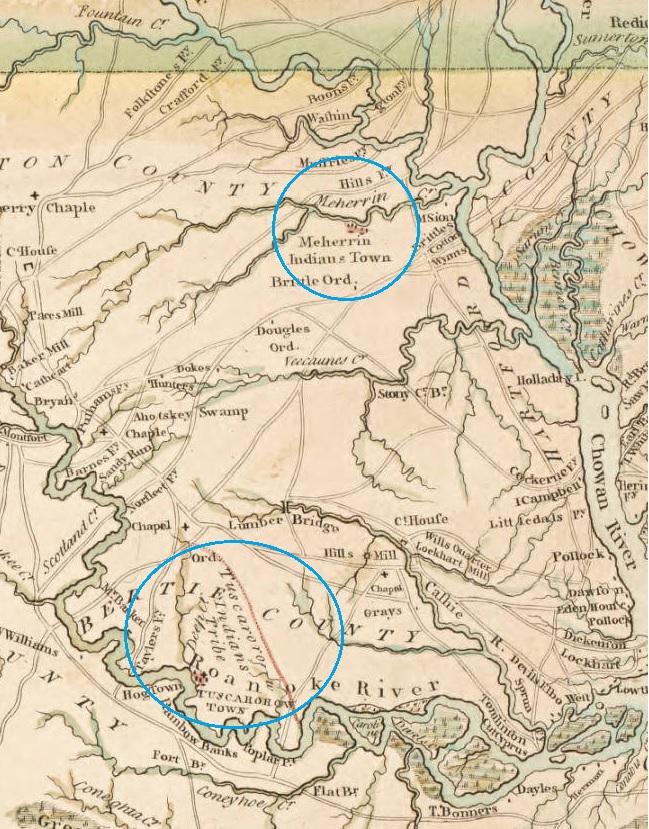
1775
Meherrin Indian Town is shown next to Potecasi Creek on this NC & SC map printed 1775.
An accurate map of North and South Carolina with their Indian frontiers, shewing in a distinct manner all the mountains, rivers, swamps, marshes, bays, creeks, harbours, sandbanks and soundings on the coasts; with the roads and Indian paths; as well as the boundary of provincial lines, the several townships and other divisions of the land in both the provinces;
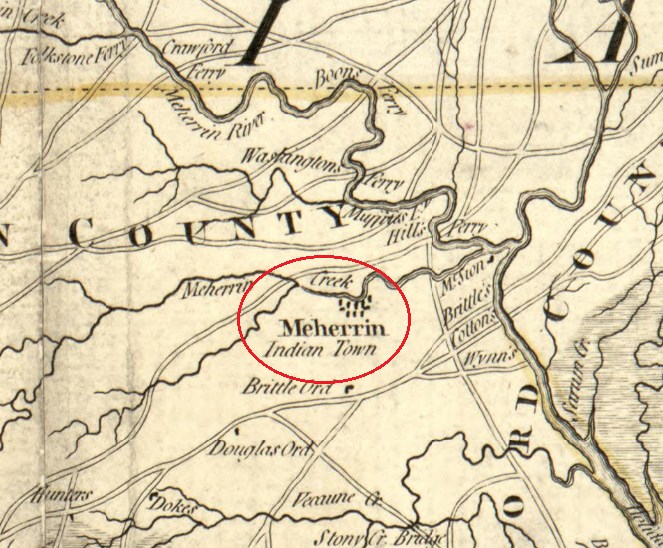
1775
Mouzon Map, Published 1775.

1776-1777
Multiple land leases were made at Indian Woods Tuscarora Reservation in nearby Bertie County. Several of the families listed on those leases are the ancestors of today’s Meherrin Tribe.
1776
Meherrins fought in the Revolutionary War.
1778
April 22, 1778 House Bill for quieting and securing the Tuscarora Indians and others claiming under the Tuscaroras, in the possession of their lands.
General Assembly Session Records related to Upper and Lower Houses
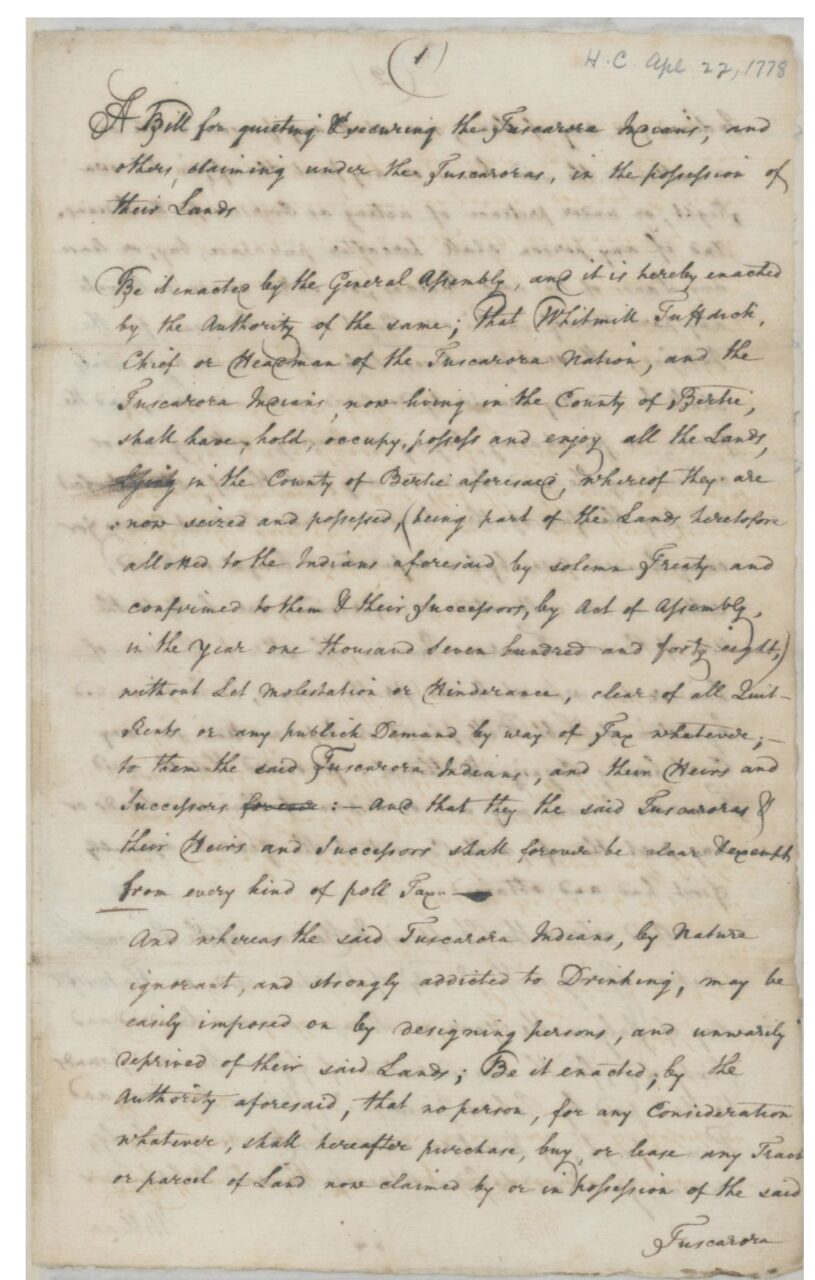
1779
The Meherrin Indians were living with the Tuscarora on the Roanoke River at the time this map titled “A New and Accurate Map of North Carolina in North America” was printed in 1779.

1780
The Meherrin Indians were living with the Tuscarora on the Roanoke River at the time this map titled “A New and Accurate Map of North Carolina, and part of South Carolina with the Field of Battle between Earl Cornwallis and General Gates” was printed in 1780.
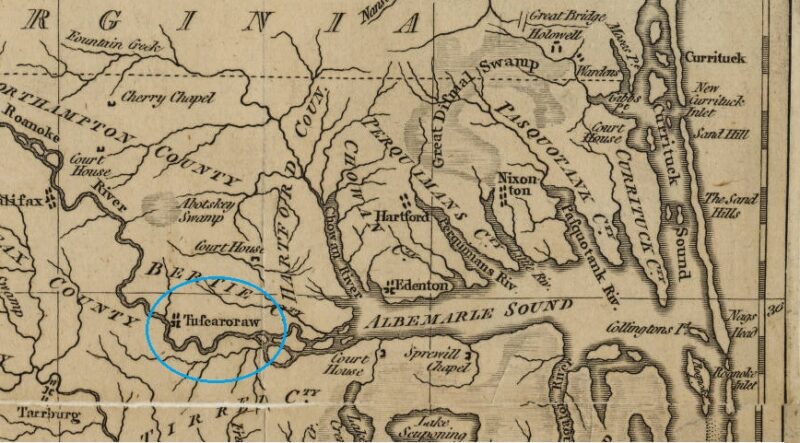
1781
“Meherrin Indians were living on the Roanoke River in 1781 with the southern bands of Tuscarora and Saponi, and the Machupunga.” -John R. Swanton
1781
Meherrin Indian Town shown on Potecasi Creek, and the Tuscarora Reservation (Indian Woods) which was also home to some Meherrin Indians.
1781 map titled: A map of the seat of war in the southern part of Virginia, North Carolina, and the northern part of South Carolina.
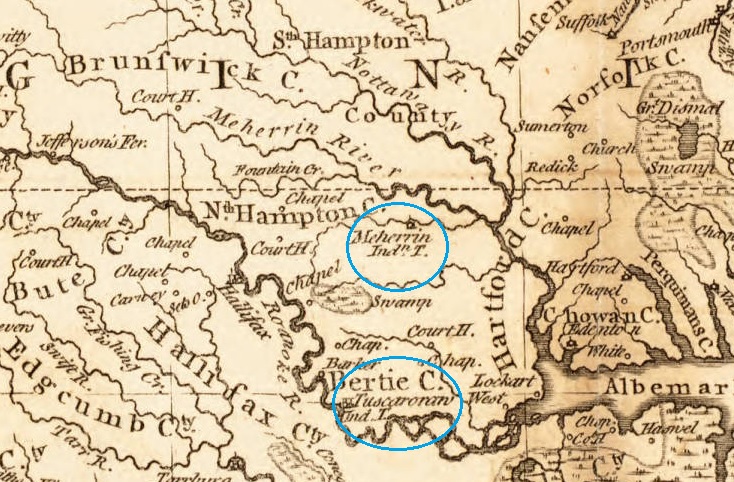
1782
“Meherrin Ville Indienne” (Meherrin Indian Village) is indicated on this 1782 French map of North Carolina and Virgina, and several other maps produced during this period. The Tuscarora are directly south at Indian Woods. Some Meherrin resided there as well in 1781.
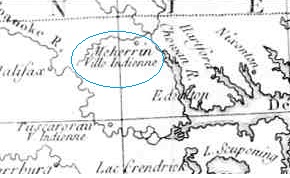
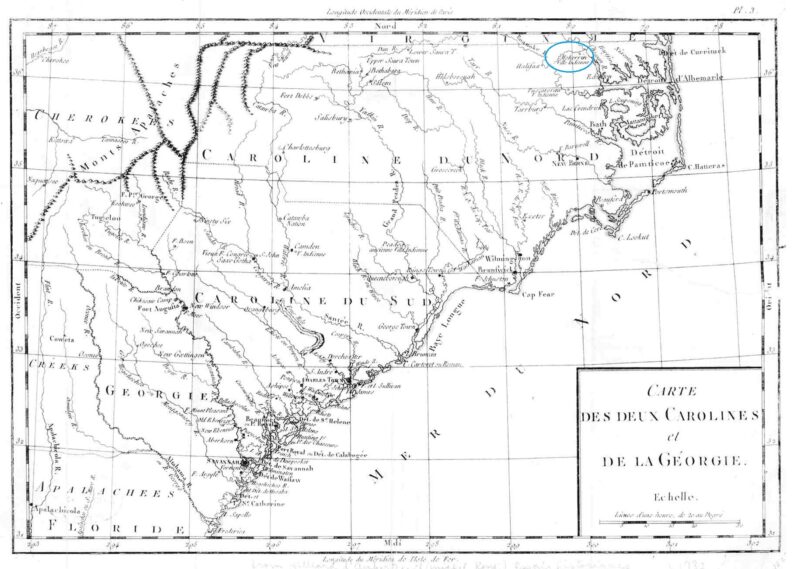
1787
Map of the marches of Cornwallis dated 1787 showing a Meherrin village on Potecasi Creek.
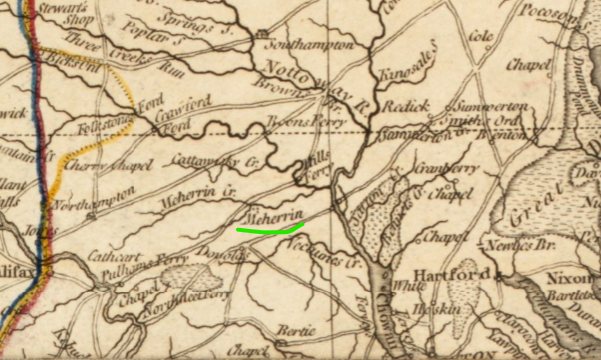

1795
Samuel Lewis’ map of North Carolina identifies Meherrin Village just south of the Potecasi Creek.
1796
Meherrin Indian Town shown on Potecasi Creek, and the Tuscarora Reservation (Indian Woods) which was also home to some Meherrin Indians.
1796 map titled: The state of North Carolina from the best authorities

1796
A Meherrin village is shown next to the Potecasi Creek on a 1796 map titled, The State of North Carolina from the best Authorities.
